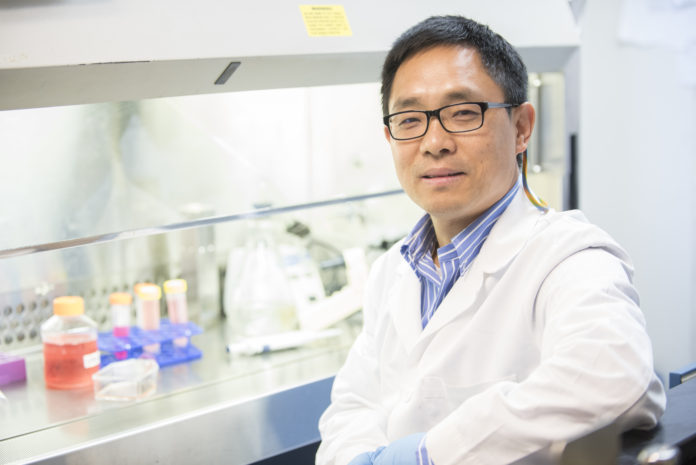
Periodontal disease is a common struggle for many Americans, affecting half of U.S. adults over 30. Now, a researcher at the University of Louisville School of Dentistry is embarking on a promising study of a potential way to help combat the disease after earning a nearly $2 million grant.
Huizhi Wang, MD, PhD, of the Department of Oral Immunology and Infectious Diseases at UofL, earned the 5-year grant for the study from the National Institute of Dental and Craniofacial Research, part of the National Institutes of Health.
Periodontal disease, a chronic inflammatory disease that affects the gum tissue and bone supporting the teeth, can have serious consequences for those who suffer from it. If left untreated, it can lead to tooth loss.
Research also has shown periodontal disease is associated with other chronic inflammatory diseases, and may be linked to cardiovascular disease, diabetes, rheumatoid arthritis and stomach and colon cancer. In Wang’s recent research, he discovered an association between P. gingivalis and esophageal squamous cell carcinoma.
“We believe periodontal disease and these conditions are connected, though we don’t know exactly why,” Wang said.
Periodontal disease is caused by the body’s excessive inflammatory response to bacteria in the mouth, specifically P. gingivalis. Wang said everyone has lots of different bacteria and fungi in their mouth, but in some people, the immune system overreacts to bacteria with ferocious inflammation. It is the inflammation that causes periodontis, not the bacteria.
Wang said most previous studies have focused on periodontal disease from the bacteria side, but few have paid attention to whether it is possible to modify the body’s responses to lessen the excessive inflammation.
He and his team have identified an intracellular molecule, serum glucocorticoid-induced kinase-1 (SGK1), that may have anti-inflammatory properties. SGK1 is a molecule usually focused on metabolism, but preliminary evidence has indicated it also may be involved in the body’s anti-inflammatory responses.
Wang will set out to see if SGK1’s abilities will expand outside a cell. “Will this molecule work in a different system? That’s what we want to find out,” he said.
In most people, the inflammatory responses to oral bacteria are tightly regulated by multiple pro-inflammatory and anti-inflammatory mechanisms. The balance of the two activities ensures a state of immune homeostasis, which is critical for protecting against microbial invasion while avoiding collateral tissue damage. Wang is hoping SGK1 may someday be used to control the inflammation that occurs when the body’s response to bacteria in the mouth is too strong.
Wang and his team have already found that those with a low level of SGK1 are more sensitive to bacteria. He believes that if the excessive inflammation could be controlled by enhancing the expression of SGK1, then the disease could be as well.
In the long term, Wang’s work could pave the way for the development of novel anti-inflammatory agents to reduce or prevent not only P. gingivalis-induced tissue destruction, but other chronic inflammatory disorders in general.
He said that if the laboratory study confirms his hypotheses that SKG1 helps control inflammation, the next question would be how to get more SKG1 into the body and test it in an animal model, such as a mouse.
If that works, Wang and his team then would look into how to take SGK1’s abilities and translate it for real-world application to fight periodontal disease, such as adding it to toothpaste or mouthwash.
Earlier this week, UofL gastroenterologist Matthew Cave, MD, was awarded $4.01 million over eight years by the National Institute of Environmental Health Sciences, one of the National Institutes of Health, to explore the long-term effects of environmental chemicals on the liver. He believes that chemicals we breathe, consume or come in contact with in the environment may be contributing to liver disease in as many as one in four people. Read his story here.


































